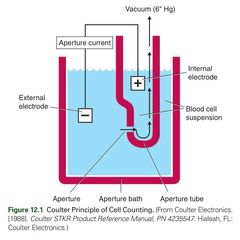![]()
![]()
![]()
Use LEFT and RIGHT arrow keys to navigate between flashcards;
Use UP and DOWN arrow keys to flip the card;
H to show hint;
A reads text to speech;
6 Cards in this Set
- Front
- Back
- 3rd side (hint)
|
1 |
2 |
|
|
|
1 |
2 |
|
|
|
1 |
2 |
|
|
|
- Typically provide the eight standard hematology parameters (complete blood count [CBC]), plus a three-part, five-part, or six-part differential leukocyte count in less than 1 minute on 200 mL or less of whole blood |
Hematology Analyzers |
Automation - Allows more efficient workload management and more timely diagnosis and treatment of disease |
|
|
Two basic principles of operation in Hematology Analyzers |
1. Electronic Impedance (resistance) 2. Optical Scatter |
|
|
|
- Cell counting is based on the detection and measurement of changes in electrical resistance produced by cells as they traverse a small aperture |
Electronic Impedance |

- Cells suspended in an electrically conductive diluent such as saline are pulled through an aperture (orifice) in a glass tube - In the counting chamber, or transducer assembly, low-frequency electrical current is applied between an external electrode (suspended in the cell dilution) and an internal electrode (housed inside the aperture tube) - Electrical resistance between the two electrodes, or impedance in the current, occurs as the cells pass through the sensing aperture, causing voltage pulses that are measurable (Figure 12.1) |

